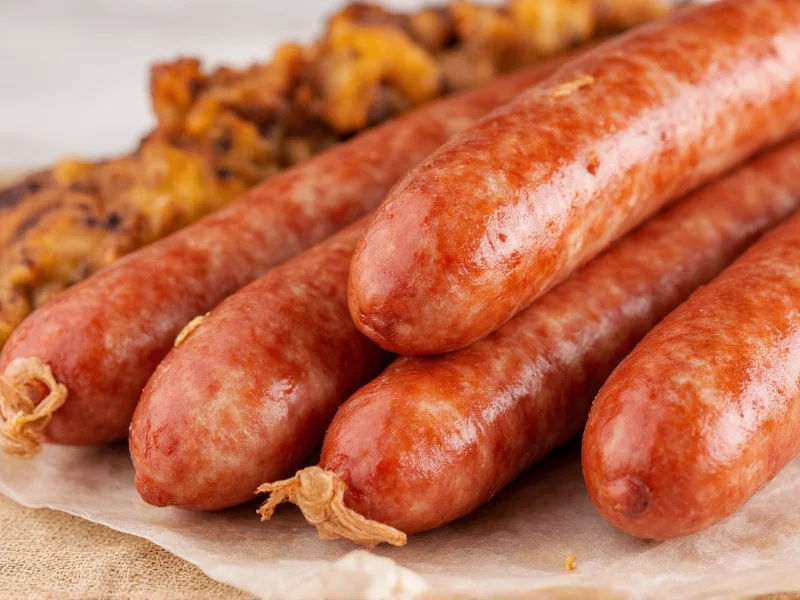Bavarian sausages represent one of Germany's most cherished culinary traditions, deeply woven into the cultural fabric of southeastern Germany. The region produces over 40 distinct sausage varieties, each with specific preparation methods and serving traditions that have been preserved for centuries. Understanding these sausages requires appreciating both their technical preparation and their social significance in Bavarian daily life and celebrations.
Historical Roots of Bavarian Sausage Making
The tradition of Bavarian sausage making dates back to the 14th century when butchers developed preservation techniques for meat in the pre-refrigeration era. Bavaria's mountainous terrain and cold climate made sausage production practical for preserving meat through winter months. The famous Weisswurst emerged in Munich around 1857 when butchers needed to use leftover veal before butchering shops closed for the day. This "morning sausage" tradition persists today, with authentic Weisswurst never sold after noon due to historical freshness concerns.
Essential Bavarian Sausage Varieties
While Weisswurst reigns supreme, Bavaria offers a diverse sausage landscape that reflects regional variations across Upper, Lower, and Middle Franconia. Each variety serves specific purposes in Bavarian dining culture, from breakfast staples to hearty main courses.
| Sausage Type | Primary Ingredients | Distinctive Features | Traditional Serving Method |
|---|---|---|---|
| Weisswurst | Finely minced veal, pork back bacon | Unsmoked, pale color, no preservatives | Boiled, served before noon with sweet mustard |
| Leberkäse | Finely ground pork, beef, bacon, onions | Meatloaf-style, not actually cheese | Sliced warm with mustard in a roll (Leberkässemmel) |
| Nürnberger Rostbratwurst | Pork, bacon, spices | Small (7-9cm), thin casing | Grilled, served with sauerkraut and potato salad |
| Blutwurst | Pig's blood, pork fat, barley, spices | Dark red, firm texture | Sliced cold with sweet mustard or fried for breakfast |
Authentic Preparation Techniques
Traditional Bavarian sausage preparation follows strict regional guidelines that distinguish authentic products from imitations. Weisswurst production exemplifies this precision: butchers combine 70% veal with 30% pork back bacon, then add parsley, lemon zest, mace, onions, ginger and cardamom. The mixture must remain below 15°C during preparation to maintain the characteristic pale color. Unlike most sausages, Weisswurst uses natural sheep casings and contains no nitrites or artificial preservatives, explaining its limited shelf life.
The distinctive preparation of Leberkäse (despite its misleading name meaning "liver cheese") involves grinding meat to an extremely fine consistency, then baking in a loaf pan until a characteristic pink crust forms. This process creates the smooth texture that makes it ideal for sandwiches. Meanwhile, Nürnberger Rostbratwurst requires specific pork cuts and a unique smoking process that gives these small sausages their intense flavor.
Cultural Significance in Bavarian Life
Bavarian sausages transcend mere food items to become cultural symbols deeply integrated into regional identity. The traditional Weisswurstfrühstück (white sausage breakfast) remains a social institution where friends gather before noon to enjoy sausages with sweet mustard, pretzels, and Weißbier (wheat beer). This ritual follows specific etiquette: never bite directly into a Weisswurst (proper technique involves slitting the casing and removing meat), and the sausages should never appear on menus after 12:00.
During Oktoberfest, over 116,000 kilograms of Bratwurst and 88,000 kilograms of pork knuckles feed thirsty festival-goers, demonstrating how sausage culture supports Bavaria's most famous celebration. Local Wurstküchen (sausage kitchens) function as community hubs where business deals are made and friendships strengthened over shared plates of Leberkäse.
Distinguishing Authentic Bavarian Sausages
True Bavarian sausages differ significantly from generic German sausages through specific regional characteristics. While northern German sausages often feature stronger vinegar notes and smoked preparations, Bavarian varieties emphasize fresh herbs and minimal processing. The Protected Geographical Indication (PGI) status for Nürnberger Rostbratwurst ensures only sausages made in Nuremberg following traditional methods can bear the name.
Authentic Bavarian sausages avoid artificial preservatives and smoke flavorings common in commercial products. The texture should be fine but not homogeneous, with visible flecks of parsley in Weisswurst and a slight graininess in properly prepared Leberkäse. When purchasing Bavarian sausages outside Germany, look for butchers specializing in German products who import directly from Bavarian manufacturers.
Traditional Serving Practices
Serving Bavarian sausages correctly matters as much as their preparation. Weisswurst traditionally arrives in a special blue-and-white porcelain dish with sweet mustard on the side, never mixed. The proper eating technique—zuzeln—involves slitting the casing lengthwise and extracting the meat with a fork or by sucking it from the casing. Blutwurst appears either sliced thin for sandwiches or pan-fried with onions for a hearty breakfast.
The classic Bavarian sausage platter combines three elements: Weisswurst or Bratwurst as the main protein, a generous portion of sweet Bavarian mustard (süßer Senf), and a soft pretzel (Brezel) with coarse salt. Beer pairing follows regional traditions—lighter Weissbier with Weisswurst, darker Dunkel with heartier sausages, and Märzen for grilled varieties.
Conclusion
Bavarian sausages represent far more than regional food specialties—they embody centuries of culinary tradition, social ritual, and cultural identity. From the delicate Weisswurst enjoyed at morning gatherings to the hearty Leberkäse sandwiches sustaining workers throughout the day, these sausages connect modern Bavarians to their heritage. Understanding the precise ingredients, preparation methods, and serving traditions transforms casual consumption into appreciation of a living culinary tradition that continues to evolve while maintaining its essential character. Whether experienced in a Munich beer garden or recreated in home kitchens worldwide, authentic Bavarian sausages offer a delicious gateway to German culinary culture.











 浙公网安备
33010002000092号
浙公网安备
33010002000092号 浙B2-20120091-4
浙B2-20120091-4